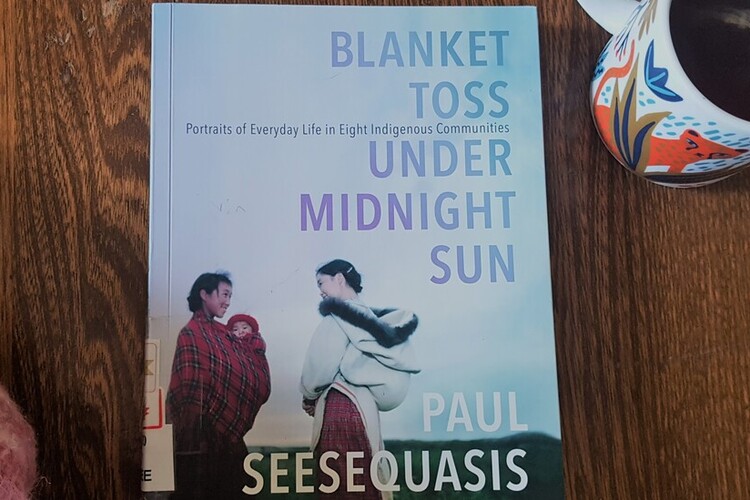Mar 15, 2021 The Saskatchewan Library Association’s (SLA) annual One Book One Province program is back, featuring the stunning book, Blanket Toss Under Midnight Sun by Saskatchewan author, Paul Seesequasis. The award-winning book exhibits photographs taken in the early 1900s to the 1970s in northern and western Canadian communities, accompanied by insightful commentary by Seesequasis. The project got its start on social media after the author felt inspired to celebrate the resilience, integrity, and both the beauty and challenges that came with everyday life within Indigenous communities. In this blog post, Heritage Saskatchewan’s Kristin Catherwood, Director of Living Heritage, and Marieke de Roos, Communications Coordinator, discuss the book, and share their thoughts on their favourite photograph. Check out this video for their full conversation! Kristin: “I first read Blanket Toss Under Midnight Sun about a year ago, and what I remembered most about it was its vibrancy. Certain photographs remained with me (including the photo Marieke writes about, of Kenojuak Ashevak emerging from her home) in their powerful simplicity. When I returned to the book this month, this quotation that Seesequasis included in the preface from Susan Sontag struck a chord. It reads, in part, “one can’t possess the present, but one can possess the past.” I thought about this as I moved through the book for the second time, and in this second reading of it, informed by that quotation, I saw the power of this work in the movement of Indigenous reclamation of their own history and heritage. In presenting these images, accompanied by succinct commentary, Seesequasis has challenged us, the readers, to reflect on what we thought we knew about Indigenous heritage in Canada and encouraged us to see it differently. These portraits, which reveal the richness of the everyday lived experiences of Indigenous people across Canada, have inspired in me the desire to learn more and to continue to challenge my understanding of the history of Canada. My favourite photo, on page 115, is of Cecil John Crowfoot, a Siksika farmer from southern Alberta, by Rosemary Eaton. Common narratives and beliefs about agriculture in Canada have historically and continue to exclude Indigenous people, and this photograph challenges those narratives. I could personally relate to the photograph as well, since Crowfoot’s easy posture on the tractor seat instantly transported me to images of my own father on a tractor, wearing a similar outfit of well-worn denim. Marieke: “I appreciated the author’s choice to highlight work from a small batch of photographers. As a result, getting to know the photographers and their subjects through their images felt a very intimate and authentic experience. We are invited to look through a window to a time and place we can never go, and that is a gift. For this reason, one pair of photos particularly struck a chord with me: They are images of Kenojuak Ashevak in Cape Dorset in 1960 taken by Rosemary Eaton, found on pages 21 and 22. The writer reveals details about her, like that she is an artist, a mother, and that she lived in the tent from which she emerges in one of the images (22). I relate to her, and it is through the similarities I draw between myself and Kenojuak Ashevak that I see our differences and become acquainted with the nuances of her life and culture. For me, this really embodies why this book is a success. It celebrates Indigenous lives in the early-mid 20th century and offers an authentic glimpse into what life was like. The book takes us to remote places of Canada, and shows us that, to the people who live there, they are not at all remote, but are home, full stop. The photos capture the vibrant daily lives of Indigenous people across what’s now known as Canada, revealing intimate details through facial expressions, activities of work and play, and material culture both mundane and exquisite, highlighting the diversity of Indigenous communities. Aesthetic details reveal the cultural complexity of Indigenous communities. The environment and how it shapes lived experiences is omnipresent. This book is, in many ways, a reclamation of Indigenous heritage. And it is a collection of lived experiences, portrayed through the powerful medium of the photograph. In the introduction, Seesequasis writes: “All photographs represent moments in time, but at their best they are also able to inspire something intangible - an emotion, an empathetic response, occasionally a realization.” This intangibility speaks also to the embedded values, beliefs, and knowledges of the people shown in these pages. The book’s beginnings on social media and the community that grew around the sharing of these photographs is a testament to the dynamic living heritage of Canada’s Indigenous people. It is an important contribution to the reclamation of Indigenous heritage in Canada, and a book to be enjoyed again and again.One Book One Province: Blanket Toss Under Midnight Sun, Book Discussion

